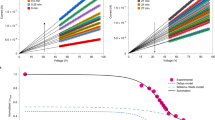Abstract
Demand for efficient window layer in thin film solar cells with high crystallinity is ever increasing that finds important application in multi-junction/tandem silicon solar cells. Doping of diborane (B2H6) in hydrogenated silicon films using plasma discharge decomposition of silane (SiH4) and (B2H6) gases were analyzed. The boron flow (FB) to silane ratio was varied from 0 to 0.30. Variation in film characteristics with B2H6 gas-phase ratio were analyzed, and concluded that doping boron induces crystallization in hydrogenated amorphous silicon (a-Si: H) film structure. The Raman and field emission scanning electron spectroscopy (FESEM) confirmed the boron induced crystallinity effect in silicon films at different diborane flow. The results showed that as boron content increases beyond certain ratio, silicon crystallization suppresses and the crystallite sizes were also reduced. From results, it was observed that crystallinity in FB = 0.05 is 79% and decreases to 77% when films are slightly higher doped (FB = 0.10) and further decreases when the films were heavily doped. These results validate that boron suppresses silicon crystallization due to local deformations caused by the impurities. Infra-red absorption studies and their analysis also confirm the crystallization in boron doped films with additional band appears at ~ 611 cm−1. This band is named as boron induced crystallinity mode of vibrational spectra. The estimated hydrogen content (CH) decreases confirmed crystallinity in the silicon structure with boron doping. Further, the energy dispersive spectroscopy (EDX) indicates the presence of boron and other impurities in deposited silicon films. The effect of boron on crystallinity and crystallite size as well as the mechanism were presented in detailed.
Similar content being viewed by others
Data Availability
My manuscript and associated personal data will be shared with Research Square to deliver the author dashboard.
References
Cuscunà M, Bonfiglietti A, Carluccio R, Mariucci L, Mecarini F, Pecora A, Fortunato G (2002) Solid State Electron 46(9):1351–1358
Fujii S, Fukawa Y, Takahashi H, Inomata Y, Okada K, Fukui K, Shirasawa K (2001) 65(1-4):269–275
Saleh R, Nickel NH (2003) 427(1-2):266–269
Yan WS, Wei DY, Guo YN, Xu S, Ong TM, Sern CC (2012) Thin Solid Films 520(6):1724–1728
Meillaud F, Shah A, Droz C, Vallat-Sauvain E, Miazza C (2006) Sol Energy Mater Sol Cells 90(18–19):2952–2959
Das D, Mondal P (2017) Appl Surf Sci 416:980–987
Limthongkul P, Jang YI, Dudney NJ, Chiang YM (2003) Acta Mater 51(4):1103–1113
Brodsky MH, Weiser K, Pettit GD (1970) Phys Rev B 1(6):2632
Greene JE, Mei L (1976) Thin Solid Films 34(1):27–30
Cho GB, Ju JH, Lee WT, Park SH, Ahn HJ, Kim KW, Nam TH (2021) J Alloys Compd 860:158507
Kamins T (2012) Polycrystalline silicon for integrated circuit applications, vol 45. Springer Science & Business Media, Berlin
Nguyen HTK, Hanafusa H, Mizukawa Y, Hayashi S, Higashi S (2021) Mater Sci Semiconduct Process 121:105357
Ohdaira K, Fujiwara T, Endo Y, Nishizaki S, Matsumura H (2009) J Appl Phys 106(4):044907
Ronning C, Borschel C, Geburt S, Niepelt R (2010) Mater Sci Eng: Rep 70(3-6):30-43
Jain IP, Agarwal G (2011) Ion beam induced surface and interface engineering. Surf Sci Rep 66(3-4):77-172
Or-Bach Z, Cronquist B, Beinglass I, De Jong JL, Sekar DC, Lim P (2013) U.S. Patent No. 8,362,482. U.S. Patent and Trademark Office, Washington, DC
Greve DW, Hatalis MK (2021) Microscopy of Semiconducting Materials, 1987. CRC Press, Boca Raton, pp 479–484
Madou MJ (2018) Fundamentals of microfabrication: the science of miniaturization. CRC Press, Boca Raton
Mokshin PV, Juneja S, Pavelyev VS (2019) J Phys: Conf Ser 1368(2):022060. IOP Publishing
Sedani SH, Yasar OF, Karaman M, Turan R (2020) Thin Solid Films 694:137639
Lien MTK, Horita S (2014) Jpn J Appl Phys 53(3S1):03CB01
Hainey MF Jr, Innocent-Dolor JL, Choudhury TH, Redwing JM (2017) J Appl Phys 121(11):115301
Chao CH, Weng KW, Cheng HL, Chan CH, Lien SY (2010) Thin Solid Films 518(24):7480–7482
Juneja S, Sudhakar S, Srivastava AK, Kumar S (2016) Thin Solid Films 619:273–280
Juneja S, Sudhakar S, Gope J, Kumar S (2015) Mater Sci Semiconduct Process 40:11–19
Li Z, Zhang X, Han G (2010) Phys status solidi (a) 207(1):144–148
Juneja S, Sudhakar S, Gope J, Lodhi K, Sharma M (2015) J Alloys Compd 643:94–99
Juneja S, Verma P, Savelyev DA, Khonina SN, Sudhakar S, Kumar S (2016) AIP Conf Proc 1724(1):020016. AIP Publishing LLC
Juneja S, Kumar S (2020) Silicon, 1-14
Yan XQ, Huang XM, Uda S, Chen MW (2005) Appl Phys Lett 87(19):191911
Stuckelberger M, Biron R, Wyrsch N, Haug FJ, Ballif C (2017) Renew Sustain Energy Rev 76:1497–1523
Juneja S, Sharma M, Kumar S (2019) Silicon 11(4):1925–1937
Funde AM, Bakr NA, Kamble DK, Hawaldar RR, Amalnerkar DP, Jadkar SR (2008) Sol Energy Mater Sol Cells 92(10):1217–1223
Acknowledgements
The authors are thankful to Director, CSIR-NPL, New Delhi for their kind support and encouragement. One of the authors Sucheta Juneja acknowledges CSIR, Govt. of India for providing Research Associateship (R.A.).
Author information
Authors and Affiliations
Contributions
The authors have equal contributions in the paper.
Corresponding author
Ethics declarations
Conflict of Interest
The authors declare that they have no conflict of interest.
Declaration of Competing Interest
The authors declare that they have no known competing financial interests or personal relationships that could have appeared to have influence the work reported in this paper.
Consent to Participate
The authors consent to participate.
Consent for Publication
The author’s consent for publication.
Research Involving Human Participants and/or Animals
Not Applicable.
Additional information
Publisher’s Note
Springer Nature remains neutral with regard to jurisdictional claims in published maps and institutional affiliations.
Rights and permissions
About this article
Cite this article
Juneja, S., Kumar, S. Boron Induced Crystallization of Silicon on Glass: an Alternate Way to Crystallize Amorphous Silicon Films for Solar Cells. Silicon 14, 10459–10466 (2022). https://doi.org/10.1007/s12633-022-01738-z
Received:
Accepted:
Published:
Issue Date:
DOI: https://doi.org/10.1007/s12633-022-01738-z



